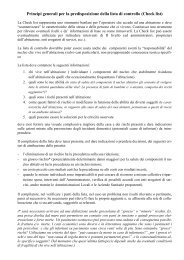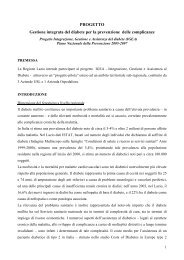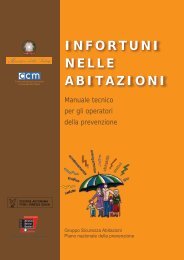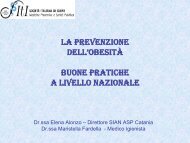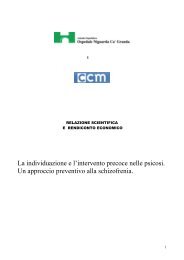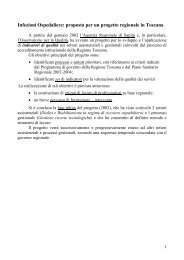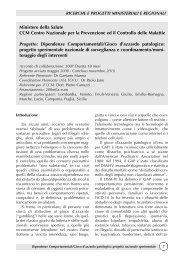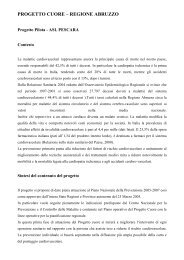Gaining health : analysis of policy development in European ...
Gaining health : analysis of policy development in European ...
Gaining health : analysis of policy development in European ...
You also want an ePaper? Increase the reach of your titles
YUMPU automatically turns print PDFs into web optimized ePapers that Google loves.
2.6. Sett<strong>in</strong>gs<br />
F<strong>in</strong>land has used the sett<strong>in</strong>gs approach for many years <strong>in</strong><br />
schools, cities and hospitals, strengthened by <strong>in</strong>volvement<br />
<strong>in</strong> <strong>in</strong>ternational networks. More recently, certa<strong>in</strong> researchers<br />
have developed standards for <strong>health</strong>-promot<strong>in</strong>g sports<br />
clubs, s<strong>in</strong>ce these play a dom<strong>in</strong>ant part <strong>in</strong> leisure activities,<br />
particularly for 10–18-year-olds (46). Economic and legislative<br />
changes have given local communities more flexibility <strong>in</strong><br />
allocat<strong>in</strong>g their state-provided resources.<br />
2.6.1. The workplace<br />
Health <strong>in</strong> the workplace is a top priority <strong>in</strong> F<strong>in</strong>land, and an<br />
occupational <strong>health</strong> care system has been <strong>in</strong> place s<strong>in</strong>ce<br />
the beg<strong>in</strong>n<strong>in</strong>g <strong>of</strong> <strong>in</strong>dustrialization. This was systematically<br />
developed after the Second World War, and particularly<br />
s<strong>in</strong>ce the 1960s (47) through collective agreements among<br />
the labour market organizations. Legal recognition was<br />
given by the 1978 Occupational Health Care Act, at a time<br />
when consensus politics functioned well, based on collective<br />
<strong>in</strong>come <strong>policy</strong> agreements. A national <strong>development</strong> plan for<br />
occupational <strong>health</strong> was <strong>in</strong>troduced <strong>in</strong> 1989.<br />
The F<strong>in</strong>nish Institute <strong>of</strong> Occupational Health supports these<br />
efforts. The Institute was orig<strong>in</strong>ally founded with f<strong>in</strong>ancial<br />
aid from the United States, partly to <strong>of</strong>fset the fact that<br />
F<strong>in</strong>land was not <strong>in</strong>cluded <strong>in</strong> the Marshall Plan. It has become<br />
one <strong>of</strong> the largest <strong>of</strong> its k<strong>in</strong>d <strong>in</strong> Europe, operat<strong>in</strong>g<br />
<strong>in</strong> conjunction with six regional branches. The Institute is<br />
now funded largely by the Government, with about 30%<br />
from external sources. In addition to research on occupational<br />
<strong>health</strong>, the work environment and work organization,<br />
frequently comb<strong>in</strong>ed with action programmes, the Institute<br />
<strong>of</strong>fers advisory services and tra<strong>in</strong><strong>in</strong>g. Two thirds <strong>of</strong> the<br />
pr<strong>of</strong>essional staff <strong>in</strong> occupational <strong>health</strong> care have received<br />
specialized tra<strong>in</strong><strong>in</strong>g. All five medical schools <strong>in</strong> the country<br />
have a pr<strong>of</strong>essorship <strong>in</strong> occupational <strong>health</strong>.<br />
Accord<strong>in</strong>g to a guide for plann<strong>in</strong>g occupational <strong>health</strong> services<br />
(47), the goals <strong>of</strong> the occupational <strong>health</strong> services are:<br />
• prevent<strong>in</strong>g <strong>health</strong> hazards and protect<strong>in</strong>g employees’<br />
<strong>health</strong>;<br />
• adapt<strong>in</strong>g work<strong>in</strong>g conditions to suit the worker;<br />
• rehabilitation;<br />
• <strong>health</strong> promotion; and<br />
• PHC.<br />
Previously, occupational <strong>health</strong> care was regarded as a<br />
series <strong>of</strong> <strong>in</strong>dividual actions respond<strong>in</strong>g to problems or risk<br />
factors related ma<strong>in</strong>ly to safety. S<strong>in</strong>ce the major occupational<br />
safety factors are now said to be largely under control,<br />
more attention has been given to <strong>health</strong> promotion,<br />
supported by important research. For over 20 years, the<br />
Institute has been concerned with the physical and mental<br />
stress encountered by people <strong>in</strong> the workplace, and by<br />
issues fac<strong>in</strong>g an age<strong>in</strong>g workforce. Musculoskeletal diseases<br />
are still the greatest cause <strong>of</strong> new work disability pensions<br />
<strong>in</strong> F<strong>in</strong>land and <strong>in</strong> 1994, every fifth employed person suffered<br />
from a chronic disease.<br />
For a number <strong>of</strong> years, the issue <strong>of</strong> labour availability has<br />
been on the agenda as labour shortages <strong>in</strong> some sectors<br />
were comb<strong>in</strong>ed with long-term unemployment, particularly<br />
among older people. There are therefore, converg<strong>in</strong>g <strong>in</strong>terests<br />
between the <strong>health</strong> and labour sectors.<br />
A long-term study <strong>of</strong> older workers led to the <strong>development</strong><br />
<strong>of</strong> the concept <strong>in</strong> F<strong>in</strong>land <strong>of</strong> “ma<strong>in</strong>ta<strong>in</strong><strong>in</strong>g work ability”<br />
(48). When the collective <strong>in</strong>comes agreement was signed<br />
<strong>in</strong> 1990, and legislation on rehabilitation was completely<br />
overhauled, the major social partners also agreed on action<br />
to ma<strong>in</strong>ta<strong>in</strong> work ability. The overhaul <strong>of</strong> the relevant legislation<br />
obliged employers to take action on the ma<strong>in</strong>tenance<br />
<strong>of</strong> work ability, and was followed by new reimbursement<br />
criteria. The aims can, however, be somewhat conflict<strong>in</strong>g:<br />
on the one hand to protect and promote <strong>in</strong>dividual <strong>health</strong><br />
at the workplace and, on the other, to reduce the numbers<br />
seek<strong>in</strong>g disability pensions and retir<strong>in</strong>g early.<br />
Chapter 4<br />
57<br />
Case studies: <strong>policy</strong> <strong>development</strong> <strong>in</strong> countries for tackl<strong>in</strong>g noncommunicable diseases



